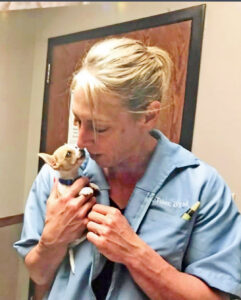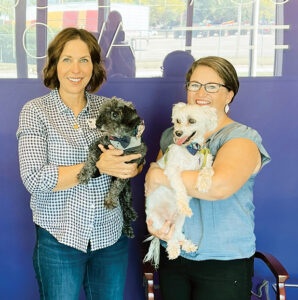A good death — Hospice and end-of-life options for your pet
10/4/2023The little black and white bundle is not much bigger than my two hands as he rolls in the long grass with feet in the air and tail wagging. The young couple is excited to show him off. My wife and I smile but worry that they will have a hard time caring for the puppy given their young busy lives.
And, sadly, that worry comes to pass. It is Christmas morning. Hauling boxes and ribbons to the garbage, we hear the little puppy whimpering and crying on the back porch, locked there since the neighbors left town the day before. So, of course my wife and children go rescue him – not for the first time. And when the couple eventually return home several days later, my wife sends me over to tell the young couple that we will not be bringing the puppy back because he is now ours. They agree.
And that is how Bear came into our lives.
THE PROBLEM
Listen, dogs and cats do not live long enough. Period. If we are lucky — or unlucky depending on your bent — we outlive our pets. This would not be a problem if you had chosen a Galapagos Giant Tortoise for a pet, as they live more than 100 years; or a Bowhead Whale, as they comfortably live past 200; or my favorite, the Greenland Shark — those bad boys live between 300 to 500 years.
But not dogs and cats. I’m so sorry. And the years are short years. The American Kennel Club has this calculation of human years versus dog years:
Fifteen human years equals the first year of a medium-sized dog’s life.
Year two for a dog equals about nine years for a human.
And after that, each human year would be approximately five years for a dog.
And size matters. A 10-year-old small dog (less than 20 pounds) is actually 56 years old. A 10-year-old medium dog (21-50 pounds) is 60 years old. A 10-year-old large dog (51-100 pounds) is 66 years old. And a 10-year-old giant dog (100-plus pounds) is already the grand old age of 79.
And cats? All cats are considered senior after 10 years. Although, from my experience, the meaner the cat, the longer they live.
All these age differences result in us humans having to deal with end-of-life decisions for our pets. And, trust me, that is a kick in the gut.
Bear, our new adopted pet, is a sheepherding dog. His movements are quick and darting. Of medium build and long fur, he has a job to do — he must keep the herd together, which means keeping us humans together. A child running down the yard away from the family needs to be chased and circled and brought back to the fold. As a result, Bear has no time off, no vacations, no lunch break. He has a job. Simple. Keep you in line.

“I know why I’m doing it. I’m doing euthanasia for a reason. I have totally accepted that. What gets me is my clients. The grief they are going through, it gets me. I’m good with the pet. The grief of the owner gets me.”
— Dr. Lisa Takes
END-OF-LIFE DECISIONS
Dr. Lisa Takes, a veterinarian with Starch Pet Hospital, is no-nonsense: the end-of-life facts are the end-of-life facts. But her compassionate eyes and her soft, gentle voice convey the emotion of putting an animal down.
“I have a conversation that is different with every client of a dying pet. Euthanasia is their personal decision. I always let them know that.”
“I take in the quality of life of the animal but also a discussion as to the owner’s grief and what is best for the owner as well.”
And how do you determine if the pet is at the end?
“I go through some guidelines with the animal. Everybody’s perception is different. Is it doing the normal things it used to do? Is it interacting? Is it alert? Is it eating? Is it drinking? Does it have mobility?”
What if the animal just seems mentally off?
“In the dementia cases, the animal is not in pain but is super anxiety-ridden. They’re panting, they can’t sleep, they’re getting stuck in corners, they’re getting lost in the house.”
And how do you decide that it is time for the pet with dementia to be put down?
“So, it’s not a pain condition but quality of life. Are we just here, or are we interacting, having a normal happy time?”
And what about when an animal stops eating?
“I have to be a little careful because some animals are super food motivated. Definitely if not eating for two or three days. That’s big. Restlessness. Can’t get comfortable. Panting. All of this is important.”
What about when it is a hip issue where the owner could spend money on hip replacements or other such things?
“I have a lot of conversations about the cost. Things are available besides hip replacement. Don’t feel guilty if you can’t afford them. I have to fit within your means, and you do the best you can with what you have. I try to talk away guilt. We all do the best we can.”
You do euthanasia at both your offices and at folks’ homes. How often are you doing it?
“I did three euthanasias yesterday. At least one or two a day. My most is seven in a day. If it needs to be done, it needs to be done.”
And what about you? Is this hard on you?
“I know why I’m doing it. I’m doing euthanasia for a reason. I have totally accepted that. What gets me is my clients. The grief they are going through, it gets me. I’m good with the pet. The grief of the owner gets me.”
Our older dog, Emma, dies, but then Bear still has our 130-pound yellow lab for a friend. Micky is a giant lap dog that merely wants to love everyone up, including the much smaller and, by then, slightly crotchety Bear. Bear tolerates this behavior because the two become hunting partners out in the country ditches and bike paths of Iowa. The much quicker Bear will roust the poor victim, and then Micky will lumber in for the coup de grace. A friendship forged under fire.

“It is one of the hardest decisions you have to make when you own pets and have them as part of your family. I love Lap of Love’s approach to everything. What I do is like doing hospice for adults. It is certainly a calling that not everyone wants to do.” — Dr. Beth Kaiser
MOBILE SERVICES FOR EUTHANASIA
Some vets associated with veterinary clinics will come to your home for euthanasia, like Starch Pet Hospital. However, there are veterinary services in the Des Moines area that are not based in brick-and-mortar veterinary clinics. These mobile services exclusively come to your home for your vet needs. One of those, Lap of Love, provides in-home euthanasia and in-home hospice.
Dr. Beth Kaiser, a cardiac nurse for eight years, returned to school at Iowa State to chase her dream of becoming a vet. She became interested in Lap of Love after practicing as a vet for a while in the Des Moines area.
“It is such an important service. The experience you can create in the home with the family and the pet and the other pets is personal and relaxed. The pets are more relaxed and the people are more relaxed.”
“I am the only veterinarian with Lap of Love in our area, so I cover about a 60-mile radius around Des Moines.”
So how does this work?
“Well, the client calls Lap of Love’s call center. And then we have what we call Veterinary Care Coordinators. They do an amazing job of answering questions and holding the family’s hand through the whole decision-making process. They are the unsung heroes. They then schedule me to come in. We are a team.”
You then come and do the euthanasia?
“It is one of the hardest decisions you have to make when you own pets and have them as part of your family. I love Lap of Love’s approach to everything. What I do is like doing hospice for adults. It is certainly a calling that not everyone wants to do.”
No kidding.
“The vast majority of my appointments are just the final appointment — in-home euthanasia. As for our hospice services, I go into the home and see where the pet is living and where the food and water bowl are located, and I walk through the home and advise how to make it easier on the pet.”
And with the euthanasia visits, how do those typically go?
“I go to the home, sit down with the family and pet to get to know both. Then I walk the family through the whole procedure so there are no surprises. Families are scared of the unknown, just what is going to happen. So, this helps them.”
And then?
“We do a strong sedative first, and that medicine usually takes about 5-10 minutes. By the time that takes effect, the pet is under an anesthesia plane. They are feeling really good. They are on cloud nine. For a lot of families to see their pet relaxed and calm is in itself a lot of comfort to families — to see their pet out of pain.”
Then?
“I give the family guidance right to the end. And then I give the final injection and let the family grieve.”
We both sit quietly.
“It’s strange to tell people I love my job, but it is such an important service to be able to walk with families through what may be one of the hardest days of their life. It is an honor to do this with them, to give the pet the passing it deserves.”
Bear got old — as we all do — becoming more and more motley with clouded eyes and a grumpy demeanor. His old buddy, Micky, passed on, and Bear was left with a youngster, Charlie the German Shepherd. Bear was not sure he liked all the tumbling and barking and tail-chasing of a young dog, and he would nip and bark at Charlie to keep some semblance of sanity at home. Charlie ignored Bear’s standoffishness and became Bear’s best friend, to Bear’s chagrin. Never hunting buddies but buddies, nonetheless.

“Our academy department typically deals with children and grieving. But there is a pet loss support group for everyone that meets once a month. Anyone can reach out to them. Cool resources for families.”
— Sanita Simms
CREMATION SERVICES
Most all of us have been to one of the Hamilton’s Funeral Homes to say goodbye to a friend or a family member, but did you know they also offer a goodbye to your pet?
Sanita Simms is the Family Service Coordinator for Hamilton’s and assists in running the Hamilton Pet Services.
“I was working part-time here, my kids had grown up, and I reached out to Holly (Miller) the president of Hamilton’s, and asked for a full-time position with pet services.”
What do you offer to a family?
“We do a private cremation, returning the remains in an urn. We also can get paw prints and a fur cutting, the pet’s name on an engraved heart, and a photo with a book box. Also a folder with all the support group information. And we do offer the option of doing a memorial service.”
And the support group?
“Our academy department typically deals with children and grieving. But there is a pet loss support group for everyone that meets once a month. Anyone can reach out to them. Cool resources for families.”
And what about you?
“I truly love my job here. Just being able to help someone when they are in grief and guide them through that process. I get so much reward out of that.”
Bear soon had difficulty taking care of himself, and we would find him confused and lost around the house. He sometimes plopped down and could no longer get up by himself. His quality of life was slipping away. Our family vet for over 20 years came out to the house as he had done a half dozen times before. He stroked and talked softly and prepared Bear for the sedative and final shot. And then it was done.
To be alive . . . and then to be dead. How can that be? Is that his wet nose in my hand looking for some love? Is that Bear chasing a squirrel along the edges of my vision? Is he herding me back to the family? Of course he is.
HOSPICE
Sometimes our pets are not yet ready to be euthanized, but they are definitely travelling down that road. And sometimes those dying pets are abandoned, strays on the streets of Des Moines. Or sometimes their owners can no longer care for them for financial reasons, or because the owner’s own health prevents the needed care. Who do you call? Animal Rescue League of Iowa (ARL) and their foster hospice program for dogs and cats.
Lora Rogers is actually the Grants & Legacy Gifts Manager for ARL, but her love of old dogs stretched that job description.
“I have a super soft spot for old animals — and dogs in particular. Myself and the board president, who loves cats, decided to do this hospice program around 2016. We supported it by a grant for several years. But we have now taken in those costs internally.”
My goodness, and how does a dog make it into the program?
“We have four veterinarians, and they are the ones who identify who is a candidate for hospice foster. For example, a lot of the dogs are in renal failure or have liver issues. There are just certain markers that don’t make them good candidates for adoption, but there is still a quality of life.”
And then what do you do?
“I assign the dog to a foster home. Some of the dogs are only in their foster homes a couple of months, but some are a couple of years. We have 10 fosters right now.”
So, who are these people that take a dying dog?
“The hospice fosters are some of my favorite people. I love them. Emily is top of the list. This is Emily’s fifth hospice foster. They are an amazing group of people.”
Emily Hubbard smiles. She cuddles with Simon and Harry, her current foster dogs.
“I started doing this in 2018. My brother worked with ARL and so I got my first one then. I love it. And they just keep sending them my way. I have another dog named Howard who started as a hospice foster, and I adopted him. He is now good. Then I have Quigley, who was supposed to just be a short term for the owner, but then the owner died, so I adopted him.”
Emily, how do you deal with the eventual death of your foster dog?
“It is not my favorite part when they die, but my family and friends get to know the dogs, and they are very supportive. And ARL is good. The three I’ve put down, the people at ARL are just so caring, like it’s their own pet.”
Emily bends over to pet Simon and Harry moving around at our feet.
Lora pauses, watching Emily: “I think a lot of times the hospice foster situation for the dog is the best life those animals have had. Emily’s even taken one hospice dog to the beach.”
And now Lora is also petting the dogs.
“And the hospice animal is frequently living just on love. And that’s enough,” says Lora. “This program is my heart. The hospice foster program just gives everybody a lot of joy.”
For my wife and I, Bear’s death is a journey that oddly brings relief from worrying about how he is doing. But the big German Shepherd, Charlie, is not so circumspect. He refuses to eat, his head hangs low, and he mopes around the house.
Charlie sits in mourning.
But then rabbits and squirrels and deer start to take over his tromping grounds. And after a respectful silence of several days, he springs to life and puts the world back to order — as we all eventually do.
But I notice today that Charlie is getting grey around the mouth. Hmmm… is that Bear barking at the back door? ♦






















